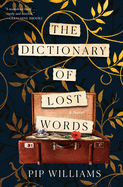
| Publisher: | Ballantine | |
| Genre: | Women, General, Biographical, Fiction, Historical | |
| ISBN: | 9780593160190 | |
| Pub Date: | April 2021 | |
| Price: | $28 |
| Starred | Fiction |
by Pip Williams
In her intriguing first historical novel, Pip Williams (One Italian Summer) follows an unconventional woman who makes the Oxford English Dictionary her life's work while secretly collecting working class and women's words deemed unworthy of its pages.
In late 19th-century England, Esme Nicoll spends her childhood hiding under tables in the Scriptorium, a garden shed in Oxford where a team of lexicographers, including her widowed father, work diligently at collecting and editing definitions on paper slips for the first Oxford English Dictionary. At age five, she swipes a slip bearing the word "bondmaid." Years later, the realization that this word applies to Lizzie, a maid and her close companion, as easily as to a Roman slave girl angers Esme. She questions why the OED leaves words out, often the language of working-class people and women. "All words are not equal," or not considered so, explains family friend and female intellectual Ditte. While remaining devoted to the OED, Esme begins using oral history techniques combined with lexicography to collect the words of market vendors, actresses and servants. As British suffragists protest and World War I draws near, writing The Dictionary of Lost Words becomes Esme's guiding purpose.
Told in Esme's gentle, inquisitive voice and spanning four decades, The Dictionary of Lost Words is a searching, feminist exploration of how class and gender affect the boundaries of language. This sweeping coming-of-age story, set against a tumultuous time in British history, is a historical fiction fan's dream. --Jaclyn Fulwood, blogger at Infinite Reads

| Publisher: | Bloomsbury | |
| Genre: | Humorous, Black Humor, Literary, Political, Thrillers, Fiction, Technological | |
| ISBN: | 9781635576207 | |
| Pub Date: | April 2021 | |
| Price: | $28 |
| Starred | Fiction |
by Dario Diofebi
In Paradise, Nevada, his staggering debut novel, Dario Diofebi has created a comic epic with the complexity and sweeping emotion to suit its singular setting, Las Vegas.
On a spring night in 2015, a bomb detonates inside the Positano Luxury Resort and Casino, a place built on the same paradoxes as Las Vegas itself, at once "both fiction and reality, both paradise and home." Months before the fateful event, four strangers converge on the Positano seeking salvation from their own personal crises: a digital poker wizard looks to make a living playing the tables after his faith in mathematics is shaken; an existentially adrift cocktail waitress finds purpose in organized labor's struggle against predatory capital; an Italian immigrant with an expired visa confronts the fear and loneliness that govern his life; and a determined Mormon journalist pursues a story with profound implications for her career and her family.
Diofebi takes a patchwork approach to his intricate plot, patiently weaving each narrative thread toward an explosive finale. Along the way, he deftly and playfully steers readers down side roads of noir and western, road novel and heist thriller. Perhaps the greatest of Diofebi's many gifts as a novelist is the psychological acuity with which he draws his characters. Even with the novel's grand staging, Diofebi keeps a keen eye on the anxieties and aspirations that animate each of his protagonists. With an abundance of warmth and humor, Paradise, Nevada establishes Dario Diofebi as an eminently thoughtful and ambitious novelist. --Theo Henderson, bookseller at Ravenna Third Place Books, Seattle, Wash.
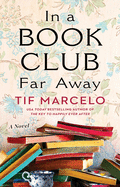
| Publisher: | Gallery Books | |
| Genre: | Women, Friendship, Family Life, General, Fiction | |
| ISBN: | 9781982148096 | |
| Pub Date: | April 2021 | |
| Price: | $16 |
| Fiction |
by Tif Marcelo
Military spouses, even former ones, don't send an SOS for just anything. So, when captain's wife Adelaide Wilson-Chang summons her two dearest friends, nurse Sophie Walden and Army veteran-turned-caterer Regina Castro, to help her out after a surgical procedure, they know it's serious. The problem? Sophie and Regina have been estranged from each other for years, since the heartbreaking end to the posting in upstate New York where they all met. Former army nurse Tif Marcelo (Once Upon a Sunset) unfolds the complicated story of the trio's friendship in her third contemporary novel, In a Book Club Far Away.
Marcelo tells her story in all three characters' voices, shifting between Adelaide's present-day medical crisis and the year the women met and formed a book club with their fellow army spouses. The plot's tension ratchets up as readers learn more about what transpired back then, and the women edge closer to confronting one another about their past betrayals and their far-reaching effects. Meanwhile, Marcelo relates, with compassion and realism, each character's present struggles: Adelaide's emergency surgery, Sophie's twin teenage girls and Regina's tentative new romance all stand alongside professional challenges for each woman. Sharing a house for two weeks, the women are forced to work through their longstanding conflict, confront long-held assumptions about one another and even squeeze in a little reading. Marcelo's warmhearted, juicy novel is a compelling portrayal of the fierce bond among military spouses and a sensitive exploration of friends trying their best to right old wrongs. --Katie Noah Gibson, blogger at Cakes, Tea and Dreams
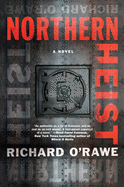
| Publisher: | Melville House | |
| Genre: | Crime, Suspense, Thrillers, Fiction, Historical | |
| ISBN: | 9781612199030 | |
| Pub Date: | April 2021 | |
| Price: | $26.99 |
| Mystery & Thriller |
by Richard O'Rawe
Belfast, Northern Ireland, 2004. Five days before Christmas. Two officials from the Northern Bank are relaxing at home with their families when their houses are invaded, kicking off one of the biggest unsolved heists in U.K. history. Former Irish Republican Army bank robber Richard O'Rawe gives a brilliant account of how it might have happened in the engrossing historical thriller Northern Heist.
James "Ructions" O'Hare and his uncle Panzer O'Hare are bank-robbing partners, but the aging Panzer's health has begun to compromise his judgment when it comes to family. Panzer's cocaine-addicted pedophile son, Finbarr, knows his dad and Ructions are planning one last big steal and thinks he's entitled to a percentage of the take. Finbarr tries to ensure a share of the money by enlisting the help of IRA bigshot Tiny Murdoch, but Tiny aims to let the robbery happen, get rid of Finbarr and keep all the money. The IRA gets a cut of any stolen bank money. They suspect what Tiny is doing. The police scramble to stop the robbery and blame it all on the IRA no matter what. Ructions must outsmart all the backstabbing, kneecapping thugs standing between him and the biggest cash grab of his life.
It's unclear which banks Richard O'Rawe targeted or how big a role he played in those heists, but his dialogue and pacing certainly imply he was there. The brutal men in his world do just as much damage with a hard look as they can with a bullet, all while sticking to a kind of honor among thieves that metes out swift justice to those who don't. --Paul Dinh-McCrillis, freelance reviewer
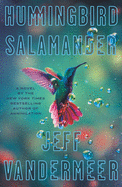
| Publisher: | MCD/Farrar, Straus and Giroux | |
| Genre: | Dystopian, Nature & the Environment, Literary, Thrillers, Fiction, Technological | |
| ISBN: | 9780374173548 | |
| Pub Date: | April 2021 | |
| Price: | $27 |
| Science Fiction & Fantasy |
by Jeff VanderMeer
Hummingbird Salamander by the prolific Jeff VanderMeer (Annihilation; The Strange Bird) is a gripping and uncanny eco-thriller that refuses to keep readers on stable ground. The novel jets into action when its protagonist, who insists readers think of her as "Jane Smith," is handed a mysterious safe deposit key by a barista. Driven by curiosity, Jane tracks down the box, only to find an invitation to an unsettling scavenger hunt inside. With only a taxidermied hummingbird and a note signed by Silvina, a dead eco-terrorist, as guides, Jane begins what ultimately becomes a years-long quest that costs her her job, separates her from her family and threatens her life.
VanderMeer is no stranger to genre bending, but in Hummingbird Salamander he finds his perfect fit: a surreal, noirish, post-apocalyptic story with an unexpected hardboiled detective at its heart. Jane and the novel's genre cut through any attempts at melodrama or sentimentality, and yet both instill a sense of inevitable world-ending that carries its own inherent pathos. As Jane's obsession with finding the "end" of this deepens, readers, too, begin to feel both the futility and yet life-giving importance of her endeavor. The more her quest to find the treasures of a lost world threatens her existence, the more desperate she becomes to sacrifice everything to take one last look at the past. While the reality of Jane's near-extinction world might be suggested to be in the future, the harrowing crisis of her near-extinction mindset remains all too present and haunting. --Alice Martin, freelance writer and editor
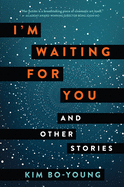
| Publisher: | Harper Voyager | |
| Genre: | Collections & Anthologies, Short Stories (single author), Epistolary, Fiction, Science Fiction | |
| ISBN: | 9780062951465 | |
| Pub Date: | April 2021 | |
| Price: | $26.99 |
| Science Fiction & Fantasy |
by Bo-Young Kim, trans. by Sophie Bowman, Sung Ryu
As impressive as Kim Bo-Young's intriguing stories are, their literary provenance is equally entertaining. "I wrote 'I'm Waiting for You' for one person to read and one person to hear, with no ambitions of it ever being published," Kim reveals in her author's note. An old friend reached out via "polite email" and, although Kim had never written a romance, requested "a story he could use to propose"! The highly successful result--both as aphrodisiac and literature--appears as the eponymous opener to Kim's four-title collection of two interlinked pairs, the first and last translated by Sophie Bowman, the middle two by Sung Ryu.
Lucky readers are wise to lean in and get ready to sigh and soar. The bracketing stories, "I'm Waiting for You" and "On My Way to You," are a he-said/she-said duet about timeless love. In between exploring such everlasting commitment, Kim includes "The Prophet of Corruption" and "That One Life"--the latter she calls "a light spinoff" of the former--in which the immortal world of connected-yet-conflicting creators observe and evaluate the machinations and manipulations they control on Earth below.
Kim, lauded as one of Korea's most influential and award-winning sci-fi writers, served as a script adviser to an earlier film by Oscar winner Bong Joon-ho of Parasite fame. Her short story "Between Zero and One" was a highlight in the 2019 anthology Readymade Bodhisattva, which introduced her work to Anglophone audiences. Kim appears poised to enjoy well-earned international acclaim. --Terry Hong, Smithsonian BookDragon
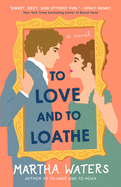
| Publisher: | Atria Books | |
| Genre: | Romantic Comedy, Historical - Regency, Romance, General, Fiction, Historical | |
| ISBN: | 9781982160876 | |
| Pub Date: | April 2021 | |
| Price: | $16.99 |
| Romance |
by Martha Waters
Following To Have and to Hoax, Martha Waters's To Love and to Loathe returns to Regency-era England with a witty enemies-to-lovers romance that sparkles with banter and tension. Young widow Diana, Lady Templeton, is looking for an affair but doesn't have the reputation to let eligible gentlemen know she might be interested. Her brother's longtime friend Jeremy, Marquess of Willingham, is known in society for his many liaisons. Isn't it convenient that they're both available at the same time, that he's holding a two-week house party and that they've been carrying a torch for each other for years?
The plot is a bit more complicated, however. Diana bets Jeremy that he'll be married within a year and enlists the help of his grandmother in her matchmaking scheme. So even as she's attempting to set him up with an eligible young woman during the house party, Diana negotiates a short-term fling with Jeremy--a practical arrangement that of course won't involve their hearts at all. "His intention had been to remind her of the strange, potent connection between them, to leave her wanting more. He had no idea... if he'd accomplished that aim--but he'd undoubtedly succeeded at reminding himself."
To Love and to Loathe is told in alternating points of view, illustrating two similarly delusional perspectives. Diana and Jeremy express their attraction through good-natured bickering as funny as it is obvious (to everyone but them). While they attempt to lie to themselves and each other, readers know the delicious truth: they've been meant for each other since the day they met. --Suzanne Krohn, editor, Love in Panels

| Publisher: | Crown | |
| Genre: | Biography & Autobiography, Women, Music, Personal Memoirs, Individual Composer & Musician | |
| ISBN: | 9780593237243 | |
| Pub Date: | April 2021 | |
| Price: | $28 |
| Biography & Memoir |
by Brandi Carlile
Cross-genre musical artist Brandi Carlile seemed to burst on the scene following a multiple Grammy-winning evening in 2019. The most nominated woman at the 61st annual awards (six), Carlile blew audiences away with her Song of the Year performance, "The Joke," an anthem for those who struggle to fit into the world's divisive molds. Thanks to Carlile's intimate memoir, Broken Horses, the story of how the "overnight sensation" struggled and strived for years can be known beyond the fans who have followed her religiously even prior to her first studio album in 2005.
Carlile's childhood in Washington State was marked by alcoholism, poverty, religion, health problems, instability (14 different homes) and, as the first-born grandchild, her own "inflated sense of self-importance and burden of perceived responsibility." That said, her family was warm, close, musical and filled with characters that lay a good storytelling foundation. But it is Carlile's sense of self and her ability to be deeply vulnerable and introspective before an audience that allow her to plumb the depths of her upbringing and forge her trail to center stage.
A brilliant lyricist, Carlile adapts her gift to the long form without missing a beat. Her style is conversational, whether the topic is music, charity work, motherhood (Carlile and her wife have two daughters), LGBTQ+ rights, Barack Obama or Carlile's beloved "gay pen pal father figure," Elton John. Overflowing with thoughtfulness, wicked humor, photographs and song lyrics, Broken Horses is an epic sit around the campfire. --Lauren O'Brien of Malcolm Avenue Review

| Publisher: | Scribner | |
| Genre: | Biography & Autobiography, Personal Memoirs, Literary Collections, Essays | |
| ISBN: | 9781982157692 | |
| Pub Date: | April 2021 | |
| Price: | $26 |
| Essays & Criticism |
by Rachel Kushner
Rachel Kushner's The Hard Crowd: Essays 2000-2020 starts with a bang: an account of her participation in the 1992 Cabo 1000, a perilous motorcycle race from San Ysidro, Calif., to Cabo San Lucas, Mexico. But in this collection, featuring 19 pieces of edgy memoir, eclectic journalism and diverse criticism, Kushner consistently delivers on the promise of that exciting opener.
Among the most entertaining entries are Kushner's reminiscences about growing up in San Francisco. "Not with the Band" describes the series of bartending jobs that brought her into the heart of the city's rock music scene in the 1990s, and features a memorable encounter with Keith Richards. In the titular essay, a video clip shot from a vehicle driving down Market Street in 1966 sparks memories of her time working in the notorious Tenderloin and living in Haight-Ashbury. But Kushner doesn't draw only on recollections of her home turf. "In the Company of Truckers" is a brief, disarming piece about a random act of kindness received while on a cross-country drive in the late 1990s.
Admirers of Kushner's novel The Flamethrowers, a finalist for the 2013 National Book Award, will delight in the essay "Made to Burn," which, in addition to Kushner's prose, features arresting images that provided some of her inspiration for the novel. Not every one of Kushner's pieces will enchant every reader, but The Hard Crowd consistently showcases the work of a conscientious, engaged journalist. Her talent for writing fiction is already well-recognized, but this introduction to her nonfiction showcases the breadth of her talent. --Harvey Freedenberg, freelance reviewer
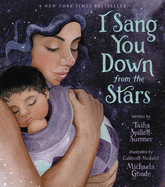
| Publisher: | Little, Brown Books for Young Readers | |
| Genre: | New Baby, Parents, Family, Legends, Myths, Fables, Indigenous Peoples of the Americas, Juvenile Fiction | |
| ISBN: | 9780316493161 | |
| Pub Date: | April 2021 | |
| Price: | $18.99 |
| Starred | Children's & Young Adult |
by Tasha Spillett-Sumner, illust. by Michaela Goade
A young Indigenous woman joyously awaits the birth of her child in this celebration of family and tradition by Cree and Trinidadian writer Tasha Spillett-Sumner (Surviving the City), with dazzling illustrations by Tlingit artist and Caldecott Medalist Michaela Goade (We Are Water Protectors).
"I loved you before I met you," the mother says. "Before I held you in my arms,/ I sang you down from the stars." Readers see her gazing up into an amethyst sky at sunset, longing for a child. The swirling white plume of a falling star's trail mingles with chimney smoke from her nearby home. Following the sweeps of stardust, she finds a white eagle feather in a strawberry patch, "the first gift in a bundle/ that will be yours." After becoming pregnant, she continues to gather items to add to the baby's bundle; after the birth, the mother sees stars reflected in her daughter's eyes. During a celebration of family and friends--most of whom share her brown skin tone while a few appear white--she realizes the baby is like a bundle filled with love and hope for the future.
While the assembling of medicine bundles is practiced primarily by Indigenous cultures, Spillet-Sumner's tender free-verse tribute to the joy of welcoming a new baby should resonate with any caregiver who has excitedly awaited a child's arrival. Her spare, uplifting lines sing with gratitude, reverence and elation. Goade's ethereal watercolor and mixed-media illustrations soar across the page, overflowing with gorgeous touches. The stardust swooshes recur, sometimes framing insets that show traditional dances, sacred images from the natural world and allusions to both Cree and Tlingit stories. I Sang You Down from the Stars will make a beautiful gift for an expecting family as well as a read-aloud to assure children they are loved. --Jaclyn Fulwood, youth services manager at Main Branch, Dayton Metro Library

| Publisher: | Pixel + Ink/Holiday House | |
| Genre: | Travel, Cooking & Food, General (see also headings under Social Themes), Family, Juvenile Fiction | |
| ISBN: | 9781645950349 | |
| Pub Date: | April 2021 | |
| Price: | $17.99 |
| Children's & Young Adult |
by Erin Soderberg Downing
When Life Gives You Lemons, Make Peach Pie is populated by quirky children, a distracted but loving parent and enough adventures and crises to pack more than one middle-grade book. Luckily, this is only Book 1 of the Great Peach Experiment series.
Two years after the death of her mother, 12-year-old Lucy Peach has settled into a new normal. Lucy is the "fixer," tending to her younger brothers, Freddy and Herb, and managing their expectations of their father, who never quite follows through with his promises. So when Dad announces that they've unexpectedly come into $1 million--thanks to the success of an invention their mother was working on before she died--and that he has purchased a food truck so that they can travel the country, Peach family feelings are... mixed. Be that as it may, in a matter of days, the Minnesota family hits the road with a plan to sell Great-Aunt Lucinda's peach pie out of their truck--and to win first prize at the Delaware, Ohio, Food Truck Festival.
Erin Soderberg Downing (Moon Shadow; the Quirk series) is exquisitely tuned in to her middle-grade readers. In addition to her sometimes poignant, often comical scenes, she includes Freddy's drawings and commentary, Lucy's droll letters to Great-Aunt Lucinda, an excellent seventh-grade book list and maps of the Peach family's progress through the Midwest. In When Life Gives You Lemons, Downing gently but candidly takes on the diverse ways a family grieves, allowing Lucy and the others to come to a bittersweet conclusion: "The time had come to let go of what was, and accept what is." And don't fret: a certain kind of reader will be satisfied to know that yes, someone does eventually get a pie in the face. --Emilie Coulter, freelance writer and editor

| Publisher: | Candlewick Press | |
| Genre: | Humorous Stories, Animals, Space Exploration, General, Juvenile Fiction, Science Fiction | |
| ISBN: | 9781536215625 | |
| Pub Date: | April 2021 | |
| Price: | $18.99 |
| Children's & Young Adult |
by Jon Klassen, illust. by Jon Klassen
In his fourth solo picture book, Caldecott Medalist Jon Klassen (This Is Not My Hat) offers readers a collection of five bite-size, hilariously deadpan stories centered around a massive, mysterious rock that falls from the sky. Enacted by his trademark dot-eyed animals in hats, each brief comedy hews to the sly, cheeky sense of humor and precise timing readers have come to recognize as a hallmark of Klassen's work.
The titular stone looms into view even before the title page, an ominous, archetypal boulder mottled black and gray like a storm cloud. The first, longest story, "The Rock," opens on a lone pink flower standing on flat land against a softly lit horizon. A turtle in a black bowler hat walks onto the page and stands by the flower, both animal and plant made tiny by the massive dusky blue-gray sky. The turtle proclaims the spot its favorite, adding, "I don't ever want to stand anywhere else." With the page turn, readers realize the rock seen earlier is hurtling through the sky toward an unknown target. The turtle is joined by a long-snouted, banded animal. This creature from Klassen's imagination--not quite an armadillo, not quite a mole--also wears a black bowler. The armoledillo agrees to share the turtle's spot but soon gets a bad feeling about it and finds another spot, all the way across the double-page spread, next to a green shoot. The turtle, now a significant distance away from its friend, yells, "HOW DOES THAT SPOT FEEL?" Unable to hear across the expanse, the armoledillo walks back to the turtle, who asks, "Does this spot still feel bad?" The armoledillo, the whites of its eyes huge around the black dot pupil, responds, "Yes. It feels even worse than before. I am going back to the other spot." By this time, readers will likely realize the rock--which continues its descent--is plummeting toward one of the spots. But which one? A brown snake with triangular markings and a black beret arrives on the scene. "Oh, hello. I am standing in this spot by myself," the armoledillo says. "Come. Stand in it with me." The turtle, perhaps jealous, shouts, "MY SPOT IS BETTER." Again, the armoledillo cannot hear. Klassen uses the suspense of the page turn to demonstrate the turtle's slow pace--"I AM COMING CLOSER"--by giving it two page turns to walk to its companions: "I said my spot is better." The next page turn shows the massive egg-shaped rock crashing to earth and obliterating the pink flower. Klassen, with his keen sense of how to make the greatest impact, ends the story there. The animals stare at the rock in pop-eyed, silent horror, a laugh-out-loud hilarious tension breaker punctuating a near-tragedy.
The four stories that follow "The Rock" build on it and each other, using the boulder as a set piece. In "The Fall," the reader sees the turtle fall from the rock and land on its shell. When offered help by the armoledillo, it insists, "I never need help." Tables turn when the turtle suggests a nap and the armoledillo claims, "I am never tired." While children may not recognize themselves in these refusals, caregivers will likely see the parallels and chuckle. In the surrealist outing "The Future," the turtle and armoledillo get more than they bargained for when they lose control of their own imagined scenario and summon a terrifying creature. This story might speak to a small child's capacity for boundless imagination and how that couples with an incomplete comprehension of the scope of reality. "The Sunset" finds the turtle unwittingly racing the sun to find out why the snake and armoledillo are sitting under the rock.
"No More Room," the final entry, ties the collection together in side-splitting fashion. In a fit of jealous pique, the turtle storms to the second spot after finding the snake and armoledillo snoozing together in the spot with the rock. The resolution remixes the recurring gags of not hearing each other across the distance and the turtle's slow pace with a cameo from "The Future" monster and a deus ex machina resolution far too funny to spoil.
Klassen's signature minimalist sensibilities rule each episode, his muted palette and deceptively understated character design lending sophistication while also supporting young readers who are still developing visual literacy skills. With so little visual noise, actions come through clearly. The same philosophy of restraint applies to body language and expression; characters communicate their entire range of emotion through the position of their dot pupils and how widely they open their eyes. The two-dimensional setting, with its flat ground and vast sky, suggests readers are watching the action unfold on a stage with the proscenium arch removed. Klassen seems to relish getting big laughs through small nudges, and much of the humor relies simply on blocking. Absent a narrator, each episode takes context solely from dialogue between the turtle and armoledillo, their lines differentiated by black and gray text respectively. Its simple sentence structure offers emerging readers a foothold for enjoying it independently.
Safe scares, sight gags and a healthy respect for readers' abilities to read between the lines make The Rock from the Sky a rare treat. Since Klassen tends to work collaboratively more often than alone, the release of five of his stories in a single volume feels like an embarrassment of riches. Adults will want to make a point of sharing this savvy and creative assortment with their young readers, or perhaps with other grownups who appreciate a masterpiece of well-executed dry humor. --Jaclyn Fulwood